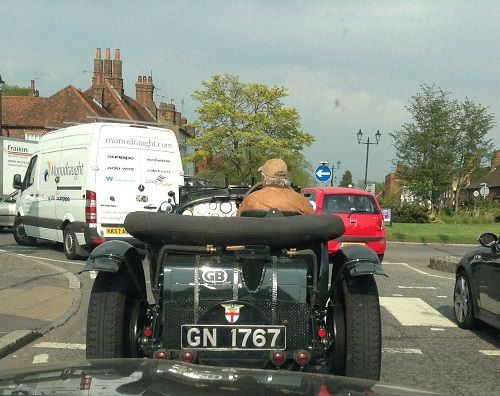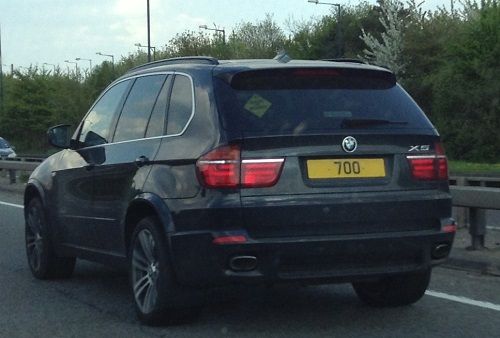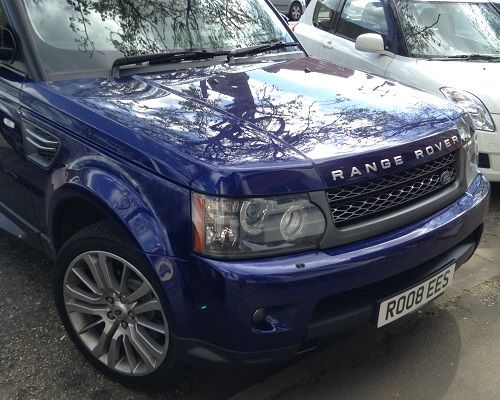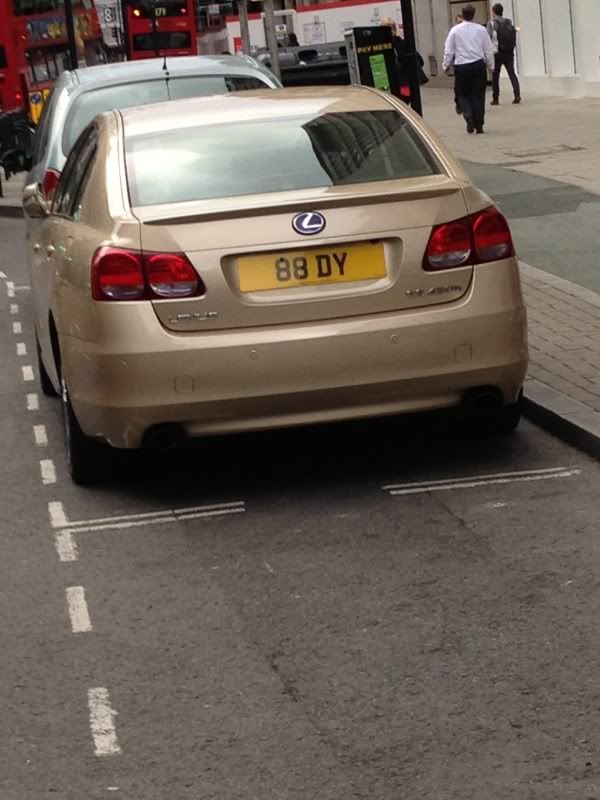Navigation
Install the app
How to install the app on iOS
Follow along with the video below to see how to install our site as a web app on your home screen.
Note: This feature may not be available in some browsers.
More options
You are using an out of date browser. It may not display this or other websites correctly.
You should upgrade or use an alternative browser.
You should upgrade or use an alternative browser.
Anyone seen any good number plates on cars lately?
BBC News - Why do people still buy personalised number plates?
Last year the UK's Driver and Vehicle Licensing Agency raised £67m from the sale of personalised number plates. But why do people still buy them?
Lord Alan Sugar has one: AMS 1. The Duke and Duchess of Cambridge drove away from their wedding with one that read JU5T WED and broadcaster Chris Evans has several.
But it's not only the rich and famous who buy personalised number plates. Despite the recent economic downturn, they are still big business.
Personalised plates are regularly used in films and television series to hint that a character is a braggart or an egomaniac or just a bit desperate for attention.
In the TV series The Persuaders, international playboy Brett Sinclair, 15th Earl of Marnock, drove an Aston Martin DBS with the number plate BS 1. In the 1964 Bond film Goldfinger, the villain had AU 1 on his 1937 Rolls Royce Phantom III Sedanca de Ville.
For the thousands of drivers who actually have personalised number plates, they are regarded as a statement of individuality or an investment. To many of the vast majority that don't have one they're an ostentatious waste of cash.
Retired businessman Robert Harverson, from Surrey, paid almost £250,000 for the registration 1 RH in November 2008. He went to the auction in Yorkshire intending to spend between £100,000 and £150,000 but recalls that - once there - he thought: "It's my initials, there's only one, so I've got to keep bidding."
He admits it is a kind of statement but no different to spending a lot on a car or boat.
"I was brought up in a one-bed flat with five of us, hand to mouth. I've worked hard in life so I can buy what I want."
But Harverson's attitude to the plate has shifted slightly. "I don't have any regrets in life but I wouldn't buy it again. In the last five to six years my mindset has changed. I would sell it if the price was right."
Harverson currently owns six private plates and says when he first started buying them they represented good value. "They were an investment, like property, 30 years ago. You'd buy sought-after ones for a few hundred pounds. But in the last 10 years it's become a fad."
Earlier this year, Steve Holden drove 219 miles from his bed and breakfast in Yarm, north-east England, to Oxford to buy HO11 DEN. He went to the auction with a £3,000 mental limit but ended up spending £7,400 to get his hands on the plate. He already owned four others.
"I would kick myself if I let it go and saw it on someone else's car," he says. "Once you've got one, you want to buy better ones. You do get noticed quite a bit but I don't buy them to be noticed. I like them and it's a good investment."
Heather Logan and her husband Gordon own seven, including 33 GL and 33 HL. After hearing GO12 DON was being auctioned in Leeds, they made the trip from their Cleveland home in March. Mrs Logan bought the plate as a birthday present for her husband, paying £8,400. "We think of them as an investment," she says.
"If there's something you want in life, and you can afford it, then why not go out and buy it."
The BBC used freedom of information laws to obtain the 10 most expensive registration plates sold directly by the DVLA, although other plates have reportedly changed hands for larger sums privately.
Topping the DVLA list is 1 D, which was bought for £352,000 in March 2009 by a London-based Lebanese businessman who wanted a birthday present for his wife.
Motoring journalist Quentin Willson says plates fall into two distinct groups. "The number plate market is polarised between the cheesiest, chosen by people with the literary sensibilities of vampire bats, and those that look really quite good, hide the age of your car and can look really quite classic."
"It really is about being visually pleasing. They are great fun but much abused. It seems to have caught the nation's psyche. For a motoring-obsessed nation they are a suburban trinket. A number plate is a form of automotive jewellery. You can either change your car or change your number plate, and changing your number plate is cheaper."
Last year the UK's Driver and Vehicle Licensing Agency raised £67m from the sale of personalised number plates. But why do people still buy them?
Lord Alan Sugar has one: AMS 1. The Duke and Duchess of Cambridge drove away from their wedding with one that read JU5T WED and broadcaster Chris Evans has several.
But it's not only the rich and famous who buy personalised number plates. Despite the recent economic downturn, they are still big business.
Personalised plates are regularly used in films and television series to hint that a character is a braggart or an egomaniac or just a bit desperate for attention.
In the TV series The Persuaders, international playboy Brett Sinclair, 15th Earl of Marnock, drove an Aston Martin DBS with the number plate BS 1. In the 1964 Bond film Goldfinger, the villain had AU 1 on his 1937 Rolls Royce Phantom III Sedanca de Ville.
For the thousands of drivers who actually have personalised number plates, they are regarded as a statement of individuality or an investment. To many of the vast majority that don't have one they're an ostentatious waste of cash.
Retired businessman Robert Harverson, from Surrey, paid almost £250,000 for the registration 1 RH in November 2008. He went to the auction in Yorkshire intending to spend between £100,000 and £150,000 but recalls that - once there - he thought: "It's my initials, there's only one, so I've got to keep bidding."
He admits it is a kind of statement but no different to spending a lot on a car or boat.
"I was brought up in a one-bed flat with five of us, hand to mouth. I've worked hard in life so I can buy what I want."
But Harverson's attitude to the plate has shifted slightly. "I don't have any regrets in life but I wouldn't buy it again. In the last five to six years my mindset has changed. I would sell it if the price was right."
Harverson currently owns six private plates and says when he first started buying them they represented good value. "They were an investment, like property, 30 years ago. You'd buy sought-after ones for a few hundred pounds. But in the last 10 years it's become a fad."
Earlier this year, Steve Holden drove 219 miles from his bed and breakfast in Yarm, north-east England, to Oxford to buy HO11 DEN. He went to the auction with a £3,000 mental limit but ended up spending £7,400 to get his hands on the plate. He already owned four others.
"I would kick myself if I let it go and saw it on someone else's car," he says. "Once you've got one, you want to buy better ones. You do get noticed quite a bit but I don't buy them to be noticed. I like them and it's a good investment."
Heather Logan and her husband Gordon own seven, including 33 GL and 33 HL. After hearing GO12 DON was being auctioned in Leeds, they made the trip from their Cleveland home in March. Mrs Logan bought the plate as a birthday present for her husband, paying £8,400. "We think of them as an investment," she says.
"If there's something you want in life, and you can afford it, then why not go out and buy it."
The BBC used freedom of information laws to obtain the 10 most expensive registration plates sold directly by the DVLA, although other plates have reportedly changed hands for larger sums privately.
Topping the DVLA list is 1 D, which was bought for £352,000 in March 2009 by a London-based Lebanese businessman who wanted a birthday present for his wife.
Motoring journalist Quentin Willson says plates fall into two distinct groups. "The number plate market is polarised between the cheesiest, chosen by people with the literary sensibilities of vampire bats, and those that look really quite good, hide the age of your car and can look really quite classic."
"It really is about being visually pleasing. They are great fun but much abused. It seems to have caught the nation's psyche. For a motoring-obsessed nation they are a suburban trinket. A number plate is a form of automotive jewellery. You can either change your car or change your number plate, and changing your number plate is cheaper."
MOCAŠ
MB Enthusiast
GN 1767

70 O (a backward James Bond fanatic?)

RO08 EES


70 O (a backward James Bond fanatic?)

RO08 EES

I saw either a big bentley or Rolls Royce with the number plate 1 in red ??
A bit odd given 1 is assigned to a motorbike at the moment ??
A bit odd given 1 is assigned to a motorbike at the moment ??
platewaver
Active Member
renault12ts
MB Club Veteran
- Joined
- Mar 5, 2009
- Messages
- 16,674
- Car
- 2005 W215 CL500.
Jij1
MOCAŠ
MB Enthusiast
I saw either a big bentley or Rolls Royce with the number plate 1 in red ??
A bit odd given 1 is assigned to a motorbike at the moment ??
See below:
The red phantom with the number 1 on it is from Oman. It's been over here for some time now...
There's no UK-issued* plate featuring just a number 1, so what made you think it was assigned to a motorbike?
* The Bailiff of Guernsey's car carries the registration "1".
A-AvantGarde
MB Enthusiast
- Joined
- Nov 11, 2003
- Messages
- 4,693
- Location
- South Bucks
- Car
- 2023 Mercedes EQC400, 2015 Porsche 911 Turbo S, 2019 BMW X5 40i
88 DY on a Lexus GS in Holborn this afternoon:


MOCAŠ
MB Enthusiast
88 DY on a Lexus GS in Holborn this afternoon:
I saw what I thought was 33 DY on a pale-coloured Citroën Picasso-type thing coming towards me in Iver on Monday. Then an hour or so later, the same car drove past me in Gerrards Cross, only this time the (rear) number plate looked more like 33 DT. Curiously, though, neither of those numbers is registered to a Citroën (one's on an Aston Martin, the other's on a Bentley)...
A-AvantGarde
MB Enthusiast
- Joined
- Nov 11, 2003
- Messages
- 4,693
- Location
- South Bucks
- Car
- 2023 Mercedes EQC400, 2015 Porsche 911 Turbo S, 2019 BMW X5 40i
I saw what I thought was 33 DY on a pale-coloured Citroën Picasso-type thing coming towards me in Iver on Monday. Then an hour or so later, the same car drove past me in Gerrards Cross, only this time the (rear) number plate looked more like 33 DT. Curiously, though, neither of those numbers is registered to a Citroën (one's on an Aston Martin, the other's on a Bentley)...
How odd. That's in my neck of the woods, I'll keep a look out...
MOCAŠ
MB Enthusiast
How odd. That's in my neck of the woods, I'll keep a look out...
I thnk it's probably based in Iver. Seem to recall it was coming out of a side-road there when I first saw it, and was heading back that way the second time I saw it.
See below:
There's no UK-issued* plate featuring just a number 1, so what made you think it was assigned to a motorbike?
* The Bailiff of Guernsey's car carries the registration "1".
Askmid shows 1 is registered to a bike ??
MOCAŠ
MB Enthusiast
Askmid shows 1 is registered to a bike ??
AskMID only covers cars insured within the UK, so I think that result can be put down to a glitch in their system. Hope you didn't spend £4 to find that out...
Jonnygearbox
Member
- Joined
- Dec 15, 2012
- Messages
- 39
- Car
- C63 AMG Edition 125
Northern ireland plates are getting very common on the mainland, I live in northern ireland anyway so we get both styles, Mainland and Northern Ireland Which are 3 letters then 4 numbers normally but they vary with 3 letters 2 numbers even as low as 1 number, nicer plates imho than the mainland letters numbers letters setup
MOCAŠ
MB Enthusiast
Northern ireland plates are getting very common on the mainland, I live in northern ireland anyway so we get both styles, Mainland and Northern Ireland Which are 3 letters then 4 numbers normally but they vary with 3 letters 2 numbers even as low as 1 number, nicer plates imho than the mainland letters numbers letters setup
Don't forget some NI plates only have two letters.
Jonnygearbox
Member
- Joined
- Dec 15, 2012
- Messages
- 39
- Car
- C63 AMG Edition 125
most ones actually being put on new cars are 3 letters
Jonnygearbox
Member
- Joined
- Dec 15, 2012
- Messages
- 39
- Car
- C63 AMG Edition 125
Conquistador
MB Enthusiast
Spotted L1 AMS a while ago in Soho and now L11AMS next to JG 123


GO09 BYE

11 OVE



GO09 BYE

11 OVE

Last edited:
MarriedBlonde
Active Member
- Joined
- Jul 9, 2006
- Messages
- 961
- Location
- Sunny South Coast (Nr southampton)
- Car
- C63 AMG Coupe/ML350 Cdi Sport/69 vw Bus
I like the x5 
Theres a 7 series BM with LI KAU normally parked by the DfT in the city
Theres a 7 series BM with LI KAU normally parked by the DfT in the city
Users who are viewing this thread
Total: 1 (members: 0, guests: 1)
Similar threads
- Replies
- 37
- Views
- 13K
- Replies
- 22
- Views
- 6K


